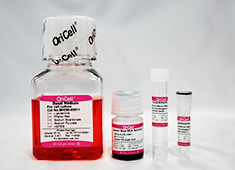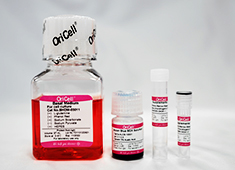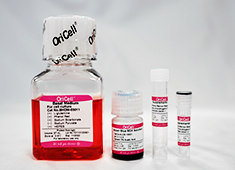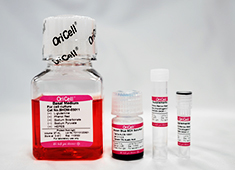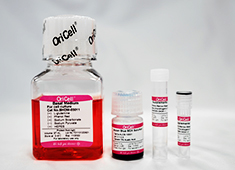OriCell™ Chondrogenic Differentiation Medium For Human Bone Marrow Mesenchymal Stem Cells
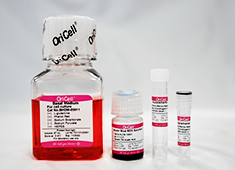
Introduction
OriCell™ Chondrogenic Differentiation Medium For Human Bone Marrow Mesenchymal Stem Cells, carefully developed by the OriCell™ R&D team, contains a basic medium and various additives which are suitable for the growth of human bone marrow mesenchymal stem cells. Extensive data demonstrate that this product can induce these cells to differentiate efficiently and stably into cartilage tissue.
Note: This product is only provided for further scientific research. It is not intended for diagnostic, therapeutic, clinical, household, or any other applications.
When citing our products in academic journals, please indicate “OriCell™ + Catalog Number, from Cyagen Biosciences(Guangzhou)Inc.”
Product Information
| Components | Catalog Number | Volume |
| OriCell™ Basal Medium For Cell Culture | BHDM-03011 | 97 mL |
| OriCell™ Supplement For Human Bone Marrow Mesenchymal Stem Cells Chondrogenic Differentiation I | HUXMX-04041-1 | 2 mL |
| OriCell™ Supplement For Human Bone Marrow Mesenchymal Stem Cells Chondrogenic Differentiation II | HUXMX-04041-2 | 1 mL |
| Alcian Blue 8GX Solultion(pH=2.2) | ALCB-10001 | 5 mL |
QC
- Pass the detection of bacteria, fungi, mycoplasma and endotoxins.
- Pass the detection of osmotic pressure and pH.
- Pass the detection of product quality.
Please reference "COA" for details.
General Handing Principles
- Ensure that all equipment is kept clean and tidy.
- Standard operation method. Please operate according to the method described in the product manual.
- The ingredients should be properly stored in accordance with the storage conditions and used as soon as possible.
- If complete medium cannot be used in a short period of time, it should be prepared in batches according to the volume ratio of each component in the kit and stored in aliquots.
Product Stability and Storage Conditions
- All ingredients must be kept in dark place.
- The basal medium must be stored in a refrigerator at 4°C for a period of 1 year. Other components must be stored at -20°C for a period of 2 years.
- The prepared complete medium can be stored at 4°C for a period of 1 month. If the culture conditions are stable, the container has great sealing performance, and there is no alternation of hot and cold condition, the period of using can be appropriately extended, but not exceed 45 days.
- Please use all products within the expiration date. Expired ingredients may significantly affect the cell culture effect.
Preparation of premix Solution
Materials Required
- OriCell™ Chondrogenic Differentiation Medium For Human Bone Marrow Mesenchymal Stem Cells (Cat. No.: HUXMX-90041)
- Clean, sterile, and stable quality disposable consumables (pipettes, pipette tips, centrifuge tubes, etc.)
- Clean sealing film
- Aluminum foil paper and other light-avoiding materials
Steps
- At least 30 minutes before preparation, place Supplement I in a refrigerator at 4°C until it is completely thawed.
- Turn upside to down or flick the reagent tube to mix the reagent.
- Use 75% medical alcohol to carefully wipe the outer packaging of all ingredients. Open the package in the clean bench.
- Add the supplement I to OriCell™ Basal Medium For Cell Culture (Cat. No.: BHDM-03011).
- Take a little amount of basal medium, wash each bottle and tube, and add all the ingredients to the basal medium as much as possible.
- Tighten the cap of the basal medium bottle and shake it gently and thoroughly.
- Seal the bottle with parafilm, wrap the bottle with aluminum foil paper, and mark the name, preparation date and other information.
Special Reminder
- If complete medium will not be used immediately, we recommend to preparing in batches. Please prepare the required amount according to the ratio of each component in the kit, but the remaining components must be stored in accordance with their respective storage conditions and not be frozen and thawed multiple times.
- All components in the OriCell™ Chondrogenic Differentiation Medium For Human Bone Marrow Mesenchymal Stem Cells are strictly aseptically controlled. Under normal circumstances, we do not recommend sterilization again. If there is a risk of contamination during the preparation process, the complete medium can be filtered and sterilized.
- The prepared chondrogenic differentiation medium should be divided into small aliquots to avoid repeated warm bathing and refrigeration of the whole bottle of medium.
Procedure for Inducing Differentiation
Materials Required
- OriCell™ Chondrogenic Differentiation Medium For Human Bone Marrow Mesenchymal Stem Cells (Cat. No.: HUXMX-90041)
- 4% Paraformaldehyde solution or 10% Formalin solution
Steps
- Transfer 3~4×105 cells to a 15 mL centrifuge tube, and centrifuge at 250×g for 4 min at 20°C.
- Aspirate the supernatant. Add 0.5 mL into chondrogenic differentiation premix, resuspend the pellet obtained from the previous centrifugation, and centrifuge at 150×g for 5 min at 20°C.
- Repeat step 2 to wash the cells again.
- Add Supplement II, according to the proportion (add 10 μL Supplement II to 1 mL of Chondrogenic Differentiation Premix). Add the amount of Supplement II to the corresponding volume of premix to prepare a complete chondrogenic differentiation medium, and gently pipette to mix.
Note:
- Centrifuge the reagent tube briefly before sucking Additive II, so that the reagent can be collected at the bottom of the tube for use.
- Be sure to store Additive II in aliquots below -20°C, avoid repeated freezing and thawing, and can be stored for 12 months.
- The chondrogenic differentiation complete medium added with Supplement II must be prepared for immediate use, and stored at 4°C for no more than 12 h.
- Resuspend the cell pellet obtained in step 3 in 0.5 mL of chondrogenic differentiation complete medium, and centrifuge at 150×g for 5 min at 20°C.
- Unscrew the centrifuge tube cap to facilitate gas exchange. Place it upright in a CO2 incubator at 37°C, 5% CO2, and saturated humidity.
Note:1)This step does not need to aspirate the supernatant or resuspend the cells.
2)Do not shake the centrifuge tube within 24 hours.
- When the cell clusters appear clustered (usually after 24 h or 48 h, depending on the actual situation), flick the bottom of the centrifuge tube to make the cartilage ball detach from the bottom of the tube and suspend it in the liquid.
- Calculated from the beginning of inoculation, replace the cells with fresh chondrogenic induction and differentiation complete medium every 2 to 3 days, about 0.5 mL per tube.
Note:
- Be careful not to suck out the cartilage ball.
- After changing the medium, flick the centrifuge tube to make the cartilage ball detach from the bottom of the tube and suspend in the liquid.
- After changing the medium each time, be sure to loosen the cap of the centrifuge tube and put it into the incubator.
- Continue to induce until a cartilage ball with a diameter of 1.5-2 mm is formed in the tube, and then the section can be prepared for staining.
Cartilage Ball Section Staining
Materials Required
- Induced cartilage balls
- 4% Paraformaldehyde solution or 10% Formalin solution
- Anhydrous alcohol, xylene, paraffin wax
- OriCell™ Alcian Blue 8GX Solution (Cat. No.: ALCB-10001)
Steps
Note: This step takes paraffin section staining as an example. If using frozen sections, please follow the instructions for using the microtome.
- Fixed. The induced cartilage balls were washed with 1×PBS, soaked in 4% paraformaldehyde solution (or 10% formalin solution), and fixed for more than 30 minutes.
Note: The fixative solution needs to be prepared for immediate use.
- Dehydration. The fixed cartilage balls are dehydrated with gradient alcohol in the following way, each stage is 30 minutes.
50% alcohol 70% alcohol 80% alcohol 95% alcohol Anhydrous alcohol
Note:
1)Dehydration must be carried out in a covered container to prevent absorbing moisture in the air.
2)Do not soak the cartilage balls in alcohol for too long, as they are easily broken.
3)When changing alcohol, suck out low-concentration alcohol, and then add high-concentration alcohol. Avoiding movement increases the risk of fragmentation of the cartilage ball.
- Transparency. Because alcohol and paraffin wax are not compatible, it needs to pass through xylene after dehydration. The way is as follows:
- Mix xylene and anhydrous alcohol at a volume ratio of 1:1. Soak the cartilage ball in it for 2 hours.
- Soak the cartilage balls in pure xylene for 1.5 hours.
- Replace with new xylene and continue to soak for 1 hour.
Note:
1)Transparency must be carried out in a covered container to prevent absorbing moisture in the air.
2)During the transparent process, if white misty bubbles appear around the cartilage ball, it means that the water has not been removed. It should be put back in the alcohol for dehydration and then transparent.
- Dip wax. In order to remove the transparent agent in the cartilage ball and make the paraffin penetrate into the interior for embedding, a wax treatment is required.
- Mix xylene and paraffin at a volume ratio of 1:1. Soak the cartilage balls and place them in an oven at 40°C for 40 minutes.
- Soak the cartilage balls in pure paraffin and place them in an oven at 55°C for 30 minutes.
Note:
1)The wax immersion should be kept at a lower temperature as much as possible, so that the paraffin wax does not solidify.
2)The temperature must be constant, not high and low.
- Embedding. Take out the cartilage ball and place it in the mold. Pour in paraffin and let stand to cool. After the paraffin is fully cooled and formed, take it out and trim the wax block.
- Slicing. Continuous slices, each slice with a thickness of 3 μm.
- The cartilage ball slices were adhered to the glass slide with an adhesive, and dried in an oven at 35°C.
- Dewaxing.
- Soak the slices in pure xylene for 15 minutes, and replace the slices with new xylene for 10 minutes.
- Xylene and anhydrous alcohol are mixed in a volume ratio of 1:1. Soak the slices for 10 minutes.
- Use 95%, 85%, 70%, and 50% alcohol to soak the slices for 10 minutes and dry them.
- Dyeing
- Add Alcian Blue dropwise to the dried sections and stain them at 37°C for 1 h.
- Rinse the slides with tap water for 5 minutes and dry them.
- Observe the staining effect of OriCell™ Alcian Blue 8GX Solultion under the microscope. The part stained with Alcian Blue shows the internal acid mucopolysaccharide in cartilage tissue.
The Alcian Blue 8GX Solution Staining Effect
Cyagen Biosciences (Guangzhou) Inc. reserves all rights to the technical documents of OriCell™ cell culture products. Without the written permission of Cyagen Biosciences (Guangzhou) Inc. any part of this document shall not be adapted or reprinted for other commercial purposes.
- In vitro chondrogenesis of the goat bone marrow mesenchymal stem cells directed by chondrocytes in monolayer and 3-dimetional indirect co-culture system. 点击索取文献 ››
- Tumor-Conditioned Mesenchymal Stem Cells Display Hematopoietic Differentiation and Diminished Influ of Ca2+. 点击索取文献 ››
- Toll-like receptors 2 and 4 mediate the capacity of human bone marrow-derived mesenchymal stromal cells to support the proliferation andd ifferentiation of CD34+ cells in a non-synergistic way. 点击索取文献 ››
- Polycaprolactone electrospun mesh conjugated with an MSC affinity peptide for MSC homing in vivo. 点击索取文献 ››
- Macrophage Migration Inhibitory Factor Inhibits the Migration of Cartilage End Plate-Derived Stem Cells by Reacting with CD74. 点击索取文献 ››
- Species variation in the spontaneous calcification of bone marrow-derived mesenchymal stem cells. 点击索取文献 ››
- Chondrogenesis of Human Bone Marrow-Derived Mesenchymal Stem Cells Is Modulated by Complex Mechanical Stimulation and Adenoviral-Mediated Overexpression of Bone Morphogenetic Protein 2. 点击索取文献 ››
- Pro-osteogenic effects of fibrin glue in treatment of avascular necrosis of the femoral head in vivo by hepatocyte growth factor-transgenic mesenchymal stem cells. 点击索取文献 ››
- Transplantation of Human Menstrual Blood Progenitor Cells Improves Hyperglycemia by Promoting Endogenous Progenitor Differentiation in Type 1 Diabetic Mice. 点击索取文献 ››
- Angiopoietin-1 gene-modified human mesenhymal stem cells promote angiogenesis and reduce acute pancreatitis in rats. 点击索取文献 ››
- Characterization of embryonic stem-like cells derived from HEK293T cells through miR302/367 expression and their potentiality to differentiate into germ-like cells. 点击索取文献 ››
- Evaluation of intervertebral disc regeneration with implantation of bone marrow mesenchymal stem cells (BMSCs) using quantitative T2 mapping: a study in rabbits. 点击索取文献 ››
- Adipose-derived stem cell-based treatment for acute liver failure. 点击索取文献 ››
- Application of a Novel Population of Multipotent Stem Cells Derived from Skin Fibroblasts as Donor Cells in Bovine SCNT. 点击索取文献 ››
- Global Gene Expression Profiling and Alternative Splicing Events during the Chondrogenic Differentiation of Human Cartilage Endplate-Derived Stem Cells. 点击索取文献 ››
- Human adipose-derived mesenchymal stem cells repair cisplatin-induced acute kidney injury through antiapoptotic pathways. 点击索取文献 ››
- Surface modification on polycaprolactone electrospun mesh and human decalcified bone scaffold with synovium-derived mesenchymal stem cells-affinity peptide for tissue engineering. 点击索取文献 ››
- Activation and regulation of the granulation tissue derived cells with stemness-related properties. 点击索取文献 ››
- Human Articular Cartilage Progenitor Cells Are Responsive to Mechanical Stimulation and Adenoviral-Mediated Overexpression of Bone-Morphogenetic Protein 2. 点击索取文献 ››
- Localization of human adipose-derived stem cells and their effect in repair of diabetic foot ulcers in rats. 点击索取文献 ››
- Low Molecular Weight Fraction of Commercial Human Serum Albumin Induces Morphologic and Transcriptional Changes of Bone Marrow-Derived Mesenchymal Stem Cells. 点击索取文献 ››
- MIF Plays a Key Role in Regulating Tissue-Specific Chondro-Osteogenic Differentiation Fate of Human Cartilage Endplate Stem Cells under Hypoxia. 点击索取文献 ››
- Enhanced tumor growth inhibition by mesenchymal stem cells derived from iPSCs with targeted integration of interleukin24 into rDNA loci. 点击索取文献 ››
- MgAl layered double hydroxide/chitosan porous scaffolds loaded with PFTα to promote bone regeneration. 点击索取文献 ››
- Human colorectal cancer-derived mesenchymal stem cells promote colorectal cancer progression through IL-6/JAK2/STAT3 signaling. 点击索取文献 ››
- Extracellular matrix deposited by Wharton’s jelly mesenchymal stem cells enhances cell expansion and tissue specific lineage potential. 点击索取文献 ››
- Diminished membrane recruitment of Akt is instrumental in alcohol-associated osteopenia via the PTEN/Akt/GSK-3β/β-catenin axis. 点击索取文献 ››
- Comparative analysis of lncRNA and mRNA expression profiles between periodontal ligament stem cells and gingival mesenchymal stem cells. 点击索取文献 ››
- Extracellular vesicles from human urine-derived stem cells prevent osteoporosis by transferring CTHRC1 and OPG. 点击索取文献 ››
- Screen-enrich-combine circulating system to prepare MSC/β-TCP for bone repair in fractures with depressed tibial plateau. 点击索取文献 ››
- The proangiogenic effects of extracellular vesicles secreted by dental pulp stem cells derived from periodontally compromised teeth. 点击索取文献 ››
